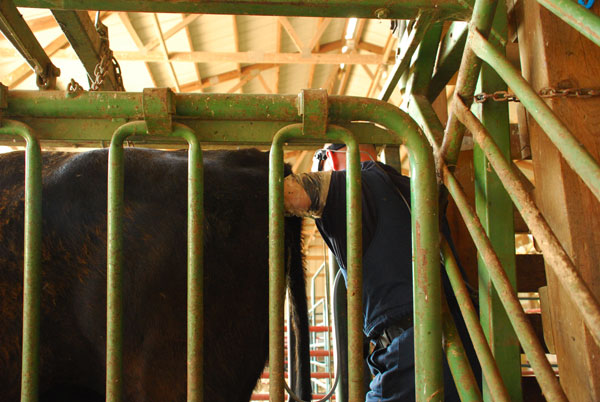Pregnancy examinations pay off for cattlemen.
October 20, 2012

As weaning time approaches, I hope most of you are planning your herd
“preg check.” If this fall is any indicator, it appears the cost of feed this fall and winter will be very high. If you have not incorporated this management practice in the past, please do so this year so that you won't be feeding non-productive females this fall and winter. When it comes time to cull cows from your herd, pregnancy status is one of the first criteria that will determine whether a cow stays in the country or goes to town.
According to the results of a survey conducted by the National Animal Health Monitoring System, fewer than 20% of beef cow-calf producers used pregnancy testing or palpation in their herd. However, the benefits of this practice are fairly simple to realize. First of all, pregnancy diagnosis allows producers to identify "open" or non-pregnant cows.
Compare the roughly $5/head cost of a pregnancy exam with the $100-200/head cost of hay alone to feed an open cow through the winter (if you can find hay for $30/roll). It's easy to see that pregnancy testing quickly pays for itself.
Second, pregnancy testing will provide a producer an estimation of when cows will be calving based on the age of the fetus at the time of the pregnancy exam. An average calving date can be calculated and the producer can use this information to better supplement the cows through the winter. Remember, the nutrient needs of cows vary throughout their production cycle; cows’ nutrient requirements are highest immediately before and after calving and are lowest in the second period of pregnancy. Knowledge of the stage of pregnancy can help producers make efficient feeding decisions. For example, most producers will have hay of varying qualities in storage. Since cows in the second period of their pregnancy require less nutrients, producers can target their lower-quality feedstuffs for the time when their cows’ nutrient requirements are the lowest.
Alternatively, producers can save their best-quality feedstuffs for the post-calving period when a cow's nutrient requirements are the highest. Thus, obtaining the pregnancy status of your cowherd will allow a producer to adjust the supplementation in a timelier manner.
Finally, if the herd needs to be culled and pregnant cows need to be sold due to drought and lack of pasture, knowing the pregnancy status of the cows will be appealing to potential buyers. Buyers will be looking to purchase cows that will calve closely in line with the cows already in their own herds.
To read the entire article, click here.
You May Also Like



